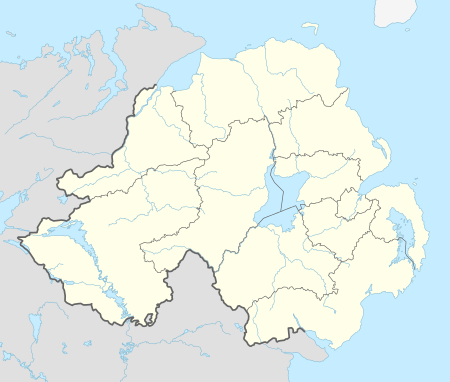Clogher
| Clogher | |
| Irish: Clochar | |
| Cathedral Church of Saint Macartan |
|
 Clogher |
|
| Population | 308 (2001 Census) |
|---|---|
| Irish grid reference | H538517 |
| – Belfast | 59 miles |
| District | Dungannon and South Tyrone |
| County | County Tyrone |
| Country | Northern Ireland |
| Sovereign state | United Kingdom |
| Post town | CLOGHER |
| Postcode district | BT76 |
| Dialling code | 028, +44 28 |
| EU Parliament | Northern Ireland |
| UK Parliament | Fermanagh and South Tyrone |
| NI Assembly | Fermanagh and South Tyrone |
|
|
Coordinates: 54°25′00″N 7°12′00″W / 54.416667°N 7.2°W
Clogher (from Irish: Clochar, meaning "stony place"[1]) is a village and civil parish in County Tyrone, Northern Ireland. It lies on the River Blackwater, 18 miles (29 km) south of Omagh. It stands on the townlands of Clogher Demesne and Clogher Tenements.[2] The United Kingdom Census of 2001 recorded a population of 309. The civil parish of Clogher covers areas of County Fermanagh as well as County Tyrone.[3]
History
The name Clochar refers to something made of stone ('Cloch' is the Irish word for 'stone' and can be anglicised as 'cloch', 'clogh' or 'clough');[4] probably on the site of the medieval monastery or a nearby ringfort.[5] Archaeological remains from before the 5th century have been found in the vicinity.[5] Clogher is said to have been the location of a gold-covered pagan oracle stone named Cermand Cestach.[6][7] The story goes that "Cloch-Ór (Golden Stone), may have been a ceremonial or oracle stone (see Cenn Cruaich and Omphalos) originally covered in gold sacred to the druids...given to Mac Cairthinn by an old pagan noble (Cairpre, the father of St Tigernach of Clones), who had harassed him in every possible way until the saint's patient love won the local ruler to the faith."[7] The stone is recorded as being "a curiosity in the porch of the Cathedral of Clogher" in the time of Annalist Cathal Maguire of Fermanagh in the late 15th century. Tighernach of Clones, later succeeded St. Mac Cairthinn as Bishop of Clogher.[8][9]
Clogher has been a religious center since St. Patrick's time and likely before.[10] St. Aedh Mac Cairthinn of Clogher (c. 430–505 AD) an early disciple and companion of Saint Patrick[11] founded a monastery at the site, which later the Synod of Rathbreasail recognised as an episcopal see. The Cathedral Church of Saint Macartan in the village is now one of two cathedrals of the Church of Ireland diocese of Clogher; the other is at Enniskillen. The Roman Catholic Diocese of Clogher has its cathedral in Monaghan. The meetinghouse of Clogher Presbyterian church is outside the village in the townland of Carntall. The "City of Clogher" was a rotten borough in the Parliament of Ireland in the gift of the Protestant bishop. The village also gives its name to the Barony of Clogher, one of the original four baronies of County Tyrone.
Transport
Clogher railway station (on the narrow gauge Clogher Valley Railway) opened on 2 May 1887, but finally closed on 1 January 1942.[12]
Clubs: sport and music
- Clogher Cricket Club plays in the NCU Senior League.
- An Clochar Éire Óg is the local Gaelic Athletic Association club supporting Irish culture within Clogher Valley.
- Clogher Valley Comhaltas, traditional music, song, dance and storytelling sessions at Augher Community Centre.
People
- Brigadier Juan Mackenna was born in Clogher in 1771. He was a hero of the Chilean War of Independence and the creator of the Corps of Military Engineers of the Chilean Army.
- The novelist William Carleton was born in the nearby townland of Prolusk (spelt Prillisk on his gravestone)in 1794.
- Percy Jocelyn, Anglican bishop of Clogher, was deposed in 1822 for Sodomitic practices.
- Soccer player Dermot McCaffrey of Dungannon Swifts grew up in Clogher.
- Bonanza King James Graham Fair, born in 1831
Education
- Carntall Primary School
- St. MacCartan's Convent Primary School
Demography
19th-century population
The population of the village decreased during the 19th century:[2][13]
| Year | 1841 | 1851 | 1861 | 1871 | 1881 | 1891 |
|---|---|---|---|---|---|---|
| Population | 702 | 558 | 389 | 242 | 225 | 273 |
| Houses | 109 | 94 | 79 | 51 | 61 | 59 |
See also
References
- ↑ "Clogher". Place Names NI. Retrieved 18 March 2013.
- 1 2 "Census of Ireland 1891". Enhanced Parliamentary Papers on Ireland. Retrieved 22 March 2013.
- ↑ "Parishes of Northern Ireland". Public Record Office of NI. Retrieved 30 December 2012.
- ↑ "Information From O'Donovan's Field Name Books : Clogh". Places.galwaylibrary.ie. Archived from the original on 9 January 2016. Retrieved 2015-11-28.
- 1 2 "16. Stone in Place Names". Ulster Place Names. Ulster Place-Name Society. Retrieved 7 May 2010.
- ↑ "Cermand Cestach". En.vionto.com. Retrieved 2015-11-28.
- 1 2
- ↑ "Celtic and Old English Saints - 4 April". Celticsaints.org. 2010-12-31. Retrieved 2015-11-28.
- ↑ "Journal of the Royal Institution of Cornwall - Royal Institution of Cornwall". Books.google.com. p. 405. Retrieved 2015-11-28.
- ↑ "Clogher". Infoplease.com. Retrieved 2015-11-28.
- ↑ "Celtic and Old English Saints - 26 March". Celticsaints.org. 2009-03-17. Retrieved 2015-11-28.
- ↑ "Clogher station" (PDF). Railscot – Irish Railways. Retrieved 16 September 2007.
- ↑ "Census of Ireland 1851". Enhanced Parliamentary Papers on Ireland. Retrieved 21 March 2013.
External links
| Wikimedia Commons has media related to Clogher. |